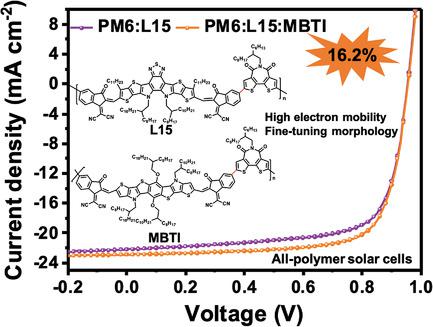当前位置:
X-MOL 学术
›
Adv. Mater.
›
论文详情
Our official English website, www.x-mol.net, welcomes your
feedback! (Note: you will need to create a separate account there.)
Regioregular Narrow-Bandgap n-Type Polymers with High Electron Mobility Enabling Highly Efficient All-Polymer Solar Cells
Advanced Materials ( IF 27.4 ) Pub Date : 2021-08-02 , DOI: 10.1002/adma.202102635 Huiliang Sun 1, 2 , Bin Liu 2, 3 , Yunlong Ma 4 , Jin-Woo Lee 5 , Jie Yang 2 , Junwei Wang 2 , Yongchun Li 2 , Bangbang Li 2 , Kui Feng 2 , Yongqiang Shi 2 , Baohua Zhang 1 , Dongxue Han 1 , Hong Meng 3 , Li Niu 1 , Bumjoon J Kim 5 , Qingdong Zheng 4 , Xugang Guo 2
Advanced Materials ( IF 27.4 ) Pub Date : 2021-08-02 , DOI: 10.1002/adma.202102635 Huiliang Sun 1, 2 , Bin Liu 2, 3 , Yunlong Ma 4 , Jin-Woo Lee 5 , Jie Yang 2 , Junwei Wang 2 , Yongchun Li 2 , Bangbang Li 2 , Kui Feng 2 , Yongqiang Shi 2 , Baohua Zhang 1 , Dongxue Han 1 , Hong Meng 3 , Li Niu 1 , Bumjoon J Kim 5 , Qingdong Zheng 4 , Xugang Guo 2
Affiliation

|
Narrow-bandgap n-type polymers with high electron mobility are urgently demanded for the development of all-polymer solar cells (all-PSCs). Here, two regioregular narrow-bandgap polymer acceptors, L15 and MBTI, with two electron-deficient segments are synthesized by copolymerizing two dibrominated fused-ring electron acceptors (FREA) with distannylated aromatic imide, respectively. Taking full advantage of the FREA and the imide, both polymer acceptors show narrow bandgap and high electron mobility. Benefiting from the more extended absorption, better backbone ordering, and higher electron mobility than those of its regiorandom analog, the L15-based all-PSC yields a high power conversion efficiency (PCE) of 15.2% when blended with the polymer donor PM6. More importantly, MBTI incorporating a benzothiophene-core FREA segment shows relatively higher frontier molecular orbital levels than L15, forming a cascade-like energy level alignment with L15 and PM6. Based on this, ternary all-PSCs are designed where MBTI is introduced as a guest into the PM6:L15 host system. Thanks to further optimal blend morphology and more balanced charge transport, the PCE is improved up to 16.2%, which is among the highest values for all-PSCs. The results demonstrate that combining an FREA and an aromatic imide to construct regioregular narrow-bandgap polymer acceptors provides an effective approach to fabricate highly efficient all-PSCs.
中文翻译:

具有高电子迁移率的区域规则窄带隙 n 型聚合物可实现高效的全聚合物太阳能电池
全聚合物太阳能电池(all-PSCs)的发展迫切需要具有高电子迁移率的窄带隙n型聚合物。在这里,通过将两个二溴化稠环电子受体 (FREA) 分别与二甲烷基化芳族酰亚胺共聚,合成了具有两个缺电子链段的两种区域规则窄带隙聚合物受体 L15 和 MBTI。充分利用 FREA 和酰亚胺,两种聚合物受体都显示出窄带隙和高电子迁移率。得益于比其区域随机类似物更广泛的吸收、更好的骨架排序和更高的电子迁移率,基于 L15 的全 PSC 在与聚合物供体 PM6.5 混合时产生 15.2% 的高功率转换效率 (PCE)。更重要的是,包含苯并噻吩核心 FREA 片段的 MBTI 显示出比 L15 更高的前沿分子轨道水平,与 L15 和 PM6 形成级联式能级对齐。基于此,设计了三元全 PSC,其中 MBTI 作为访客引入 PM6:L15 主机系统。由于进一步优化的混合形态和更平衡的电荷传输,PCE 提高了 16.2%,这是所有 PSC 的最高值之一。结果表明,结合 FREA 和芳族酰亚胺构建区域规则窄带隙聚合物受体提供了一种制造高效全 PSC 的有效方法。L15 主机系统。由于进一步优化的混合形态和更平衡的电荷传输,PCE 提高了 16.2%,这是所有 PSC 的最高值之一。结果表明,结合 FREA 和芳族酰亚胺构建区域规则窄带隙聚合物受体提供了一种制造高效全 PSC 的有效方法。L15 主机系统。由于进一步优化的混合形态和更平衡的电荷传输,PCE 提高了 16.2%,这是所有 PSC 的最高值之一。结果表明,结合 FREA 和芳族酰亚胺构建区域规则窄带隙聚合物受体提供了一种制造高效全 PSC 的有效方法。
更新日期:2021-09-14
中文翻译:

具有高电子迁移率的区域规则窄带隙 n 型聚合物可实现高效的全聚合物太阳能电池
全聚合物太阳能电池(all-PSCs)的发展迫切需要具有高电子迁移率的窄带隙n型聚合物。在这里,通过将两个二溴化稠环电子受体 (FREA) 分别与二甲烷基化芳族酰亚胺共聚,合成了具有两个缺电子链段的两种区域规则窄带隙聚合物受体 L15 和 MBTI。充分利用 FREA 和酰亚胺,两种聚合物受体都显示出窄带隙和高电子迁移率。得益于比其区域随机类似物更广泛的吸收、更好的骨架排序和更高的电子迁移率,基于 L15 的全 PSC 在与聚合物供体 PM6.5 混合时产生 15.2% 的高功率转换效率 (PCE)。更重要的是,包含苯并噻吩核心 FREA 片段的 MBTI 显示出比 L15 更高的前沿分子轨道水平,与 L15 和 PM6 形成级联式能级对齐。基于此,设计了三元全 PSC,其中 MBTI 作为访客引入 PM6:L15 主机系统。由于进一步优化的混合形态和更平衡的电荷传输,PCE 提高了 16.2%,这是所有 PSC 的最高值之一。结果表明,结合 FREA 和芳族酰亚胺构建区域规则窄带隙聚合物受体提供了一种制造高效全 PSC 的有效方法。L15 主机系统。由于进一步优化的混合形态和更平衡的电荷传输,PCE 提高了 16.2%,这是所有 PSC 的最高值之一。结果表明,结合 FREA 和芳族酰亚胺构建区域规则窄带隙聚合物受体提供了一种制造高效全 PSC 的有效方法。L15 主机系统。由于进一步优化的混合形态和更平衡的电荷传输,PCE 提高了 16.2%,这是所有 PSC 的最高值之一。结果表明,结合 FREA 和芳族酰亚胺构建区域规则窄带隙聚合物受体提供了一种制造高效全 PSC 的有效方法。











































 京公网安备 11010802027423号
京公网安备 11010802027423号